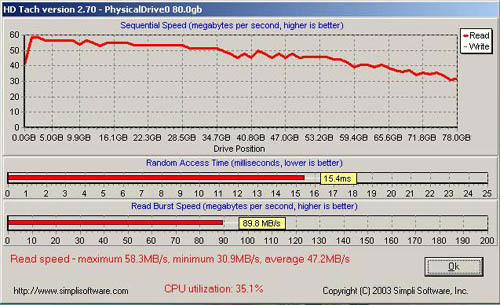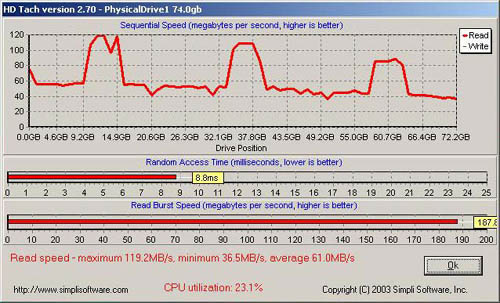nForce3-250 - Part 2: Taking Athlon 64 to the Next Level
by Wesley Fink on March 29, 2004 11:00 AM EST- Posted in
- CPUs
nForce3-250Gb: IDE and RAID Benchmarks
Disk Performance Testing can provide extremely variable results, even when test conditions are well-controlled. For that reason, we were skeptical to drop IDE and RAID tests into our review of the nForce3-250Gb. However, it was certain, given nVidia's past lackluster drive performance, that HD tests should be included in nF3-250 benchmarking.Some of the most commonly used benchmarks for Hard Drive Testing are HDtach 2.7, PCMark 2004 HD Tests and SiSoft Sandra 2004 File System Benchmark. We have included all 3 test results here for both IDE and nVidia RAID. Tests in both cases were run on Hard Drives about 20% full, with the benchmark run from the IDE hard drive. The IDE hard drive was a 7200 RPM 80GB drive with a 50GB C: boot partition, and tests were run on C:. The RAID array was 2 Western Digital Raptor 10,000 RPM 36.7GB hard drives. Both the IDE and RAID were driven by nVidia IDE drivers in nForce Platform Driver 4.04.
Sandra 2004 shows a 38% increase in throughput with nVidia 10,000RPM RAID compared to a single 10,000RPM SATA drive. PCMark 2004 HDD Test Suite shows a smaller increase in performance with RAID, around 27%. Benchmarks for a single 7200RPM IDE are also included for comparison.
Perhaps even more important for critics of past nVidia IDE implementations is that nVidia and Intel throughput in IDE is now about the same with the nForce3-250Gb. Intel SATA RAID is a bit faster in Sandra, but the difference in measured benchmark performance was very small, at about 6%.
For those who hate the numbers from benchmarks like Sandra and PCMark, the HDTach screen captures provide a very interesting snapshot. The two graphs below, with blue title bars, represent nVidia's nForce3-250Gb drive controller performance.


We also tested the Intel RAID controller with another pair of 10,000 rpm Western Digital Raptors. Those results are shown with the green title bar below.

As you can see, performance of the Intel SATA RAID and nVidia SATA RAID are virtually identical.
The biggest surprise in the HD Tach benchmarks was the fact that SATA RAID requires half the overhead of basic IDE in nVidia's implementation. However, the CPU utilization, while greatly improved over numbers we have seen for nVidia in the past, is still very high compared to Intel's SATA RAID. Part of this has to do with the architectural differences between Athlon 64 and Intel processors and chipsets, but there is still a large difference in CPU overhead between the nVidia and Intel RAID solutions. Frankly, the real performance difference is likely to be nil on the typical desktop, but this will matter to some.










46 Comments
View All Comments
jeremyk442 - Monday, March 29, 2004 - link
I was disappointed to see a comparison of the 10k RAID to a single 7200 drive. How does that show us the benefits of RAID when the 10K vs 7200 variable is in the mix. Also, performance tests of mixing SATA and IDE in RAID setups would be nice.Also, in comparison of the NVIDIA vs ATI graphics cards, the NVIDIA card was not tested on the other platforms (or at least it wasn't graphed) making it difficult to determine the benefit that the 250Gb chipset gives it. Also, I wanted some more commentary on why the chipset gives the NVIDIA card a performance advantage. It seems a little suspicious to me.
Reflex - Monday, March 29, 2004 - link
#24 beat me to the punch. Even the digital output capabilities of SoundStorm are rather inferior compared to other solutions. Its not a great sound chip, but then I covered this territory in part one.Honestly, this chipset seems lacking to me. The best part of it is the gigabit ethernet, but even that is overkill for most setups. If it had included PCI-Ex I woulda considered it a better solution, but as it is I'd rather just wait...
Odeen - Monday, March 29, 2004 - link
"Apparently you COMPLETLY overlooked the fact that most (all, AFAIK) SoundStorm boards offered digital output which bypassed those codec's completly. Which just happens to be EXACTLY what I use, and was a major selling point, allowing me to send out my DD/DTS signal to my amp for DVD's as I use for regular computer use. VERY handy."It's a nice solution, but a flawed one. It's not DTS, it's just a 640K/second 6-channel Dolby Digital stream that, because it's generated in real-time, doesn't use any "tricks" to boost effective bandwidth, just six independent channels occupying a little over 100K each, 5-to-1 compression ratio or so.
As 3dsoundsurge.com tests of the nVidia Soundstorm show, the compression essentially nukes ALL frequencies over 18,000hz. I would think that, as a sound purist, you'd object to listening to compressed audio, especially quick-and-dirty compressed audio, day in and day out.
I'd be much happier if Soundstorm either used firewire audio out for compatible receivers, which has enough bandwidth for a DVD-Audio stream(6 channel uncompressed 24/96 or stereo 24/192), or some sort of multiple digital outputs, each carrying a straight SPDIF stereo stream.
Wesley Fink - Monday, March 29, 2004 - link
#21 -We showed some benchmarks of Gigabit LAN in Part 1, Page 6 of the nForce3-250 review. We also discussed throughput benchmarks in Part 1 of the article and in front page comments in reply to questions.
With a benchmark that could actually supply 2Gb/sec to test on-chip Gb LAN, throughput for a PCI-based Gb card was around 840kb/sec, while the on-chip LAN was about 1870kb/sec - more than double the throughput.
We chose NOT to publish these benchmarks in a splashier way because you will actually see the doubling of performance only in somewhat rare situations on today's systems. Instead, we talked about where the on-chip Gb LAN would make a big difference - LAN gaming with Gigabit switches, Corporate Gigabit LAN, file-sharing on Gigabit home network. You will not, for instance, see any difference today in broad-band network connections available to most users. nVidia's on-chip LAN is a great idea that will become even more useful in the future.
Wesley Fink - Monday, March 29, 2004 - link
#19 -nVidia calls their version for Socket 939 'nForce3-250Gb Ultra', much as VIA calls K8T800 for Socket 940 the 'K8T800 Pro', and SiS calls their 939 version 755FX and not 755. Ultra, in the case of nVidia, means 1000 HT capable. I mention in the review that any of the chipsets can be used on 754 boards if the manufacturer chooses. It is also clear that the review board is based on the nForce3-250GB Ultra with 1000 HT that will be used in Socket 939 boards in the future.
Phiro - Monday, March 29, 2004 - link
One comment, one demand/request.Comment: I like nvidia's onboard sound, but if really want to decouple it from the motherboard and sell them as stand-alone cards, that's fine with me too.
Demand/Request: You had a gigabit ethernet nforce3 and you never even benchmarked the damn thing? WTF is wrong with you people? Holy jeebus - even if you don't have the hardware from other manufactors to do some good benchmarks, you could at least show us what your reference board gets talking to card X or whatever, or better yet two 250gb's xfering files to each other over a crossover cable.
Regs - Monday, March 29, 2004 - link
I want to see the K8T vs Nforce 250GB at their highest stable over clocks. I think the K8T can maybe reach 220 HTT with some difficulties, while the 250 can reach 240HTT. Then lets see some benchmarks.amalinov - Monday, March 29, 2004 - link
OK. Nvidia have not included SoundStorm in nf3, becouse it is cheaper to manufacture (and design) this way.Also I see that you have corrected the 6.1 to 6-channel.
what about the "dual channel Ultra-version"?
#16, It is posible to make a S939 dual-channel board with current nf3-250 (and also with nf3-150, SiS760, K8M800, K8T800, SiS755, ALi, AMD, etc. - ALL Opteron/A64 chipsets). Regarding PCI Express and PCI-X - they can be added to such board (based on existing chipset) too. for PCI-X - AMD8131 chip, for PCI Express - some not-yet-announced chip. Becouse of HyperTransport it is possible to combine nf3-250 with any other HT-tunnel controller supporting PCI-X, PCI Express and other interfaces.
Another question is if some mobo manufacturer will do that. Becouse of cost reasons mobo manufacturers tend to make crimpled products not utilizing all chipset functions (nf3 with only 2 UATA channels instead of 3, etc.), so wanting even more than this seems unrealistic.
amalinov - Monday, March 29, 2004 - link
OK. Nvidia have not included SoundStorm in nf3, becouse it is cheaper to manufacture (and design) this way.Also I see that you have corrected the 6.1 to 6-channel.
what about the "dual channel Ultra-version"?
#16, It is posible to make a S939 dual-channel board with current nf3-250 (and also with nf3-150, SiS760, K8M800, K8T800, SiS755, ALi, AMD, etc. - ALL Opteron/A64 chipsets). Regarding PCI Express and PCI-X - they can be added to such board (based on existing chipset) too. for PCI-X - AMD8131 chip, for PCI Express - some not-yet-announced chip. Becouse of HyperTransport it is possible to combine nf3-250 with any other HT-tunnel controller supporting PCI-X, PCI Express and other interfaces.
Another question is if some mobo manufacturer will do that. Becouse of cost reasons mobo manufacturers tend to make crimpled products not utilizing all chipset functions (nf3 with only 2 UATA channels instead of 3, etc.), so wanting even more than this seems unrealistic.
Wesley Fink - Monday, March 29, 2004 - link
#12 -We did not say Sound Storm could not be included on a single-chip, we said there was only so much real-estate PRACTICALLY available on a single chip. As complexity goes up, yields generally go down - raising the price of a chipset. This is a competetive market.
The next line in the review mentioned that nVidia is working on other sound solutions which may be included in a future chipset or separate card. This may be the most important reason why we did not see Sound Storm in nF3-250.